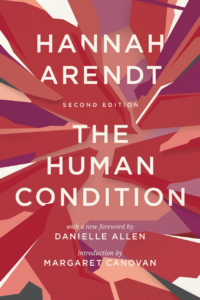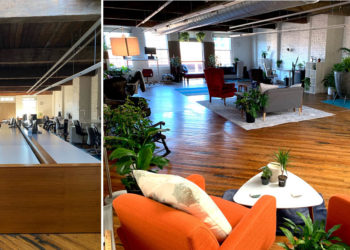Of late, I have been considering the nature of work, and how this may change as we embrace AI in the workplace. I thought I should turn for help to the brilliant mind of Hannah Arendt, perhaps the most important political theorist of the 20th century.
In this post I look to Hannah Arendt, and her 1958 book, The Human Condition (a formative book for me), for help in understanding the nature of how we work, be it remotely, in the office, or a hybrid of the two. I ask how an AI world may affect the nature of our work. Is there a special human resonance in the way we work together that allows us to be fulfilled and effective as our jobs evolve in an AI world?
Perhaps it is worth beginning by understanding a little about Hannah Arendt. As a Jewish German, born in 1906, she escaped the Nazis in 1933, lived in Paris, and then escaped again to the USA when the Nazis invaded France. Her books were informed by the horrors of the Holocaust: this is where she and I bond, as much of my experience of the world is shaped by a family history that experienced these horrors first-hand – my mother and aunt were on the Kindertransport from Vienna in 1938, with my grandparents killed in Buchenwald and Auschwitz respectively. Hannah Arendt tries to understand the world through this lens of horror, and yet is relentlessly optimistic with deep insights into human relationships, such as the differences between solitude and loneliness, the political and social threats that accompany loneliness, and the value of working together.
2020 changed our lives, both at home and at work. We worked remotely, set up systems to support this, and then when the pandemic waned, found it hard to relinquish remote work, despite a longing for in-person connections. Hybrid work evolved, and for many this is the status quo, with employees balancing one type of work in the office – meetings, discussion, more meetings, lunch in the cafeteria – and so on, with a more contemplative form of work at home. At home there is a quieter kind of work. And of course, Zoom exists, dragging many of us into an arguably more depersonalized human contact on screen. As AI encroaches, will this trend toward depersonalization increase? What role will we humans play in all of this? How will our human connections allow us to be effective and fulfilled? Are we most efficient as social animals?
Perhaps it is now worth turning now to Arendt’s book. Arendt defines something she terms vita activa, which contains three elements: labor, work and action.
“ Labor is the activity which corresponds to the biological process of the human body, whose spontaneous growth, metabolism, and eventual decay are bound to the vital necessities produced and fed into the life process by labor. The human condition of labor is life itself”
In other words, when we labor, we do what we must to survive.
“Work is the activity which corresponds to the unnaturalness of human existence, which is not imbedded in, and whose mortality is not compensated by, the species’ ever recurring life cycle. Work provides an “artificial” world of things…..The human condition of work is worldliness.”
In other words, when we work we produce something that lasts – Arendt liked to focus on furniture as examples of such work.
“Action, the only activity that goes on directly between men without the intermediary of things or matter, corresponds to the human condition of plurality, to the fact that men, not Man, live on the earth and inhabit the world….”
In other words, action is an activity we choose, which has purpose, and is pursued in a social context. For Arendt, action is the path for humans to engage and realize their potential in context of work and labor. For Arendt, action is inherently political.
So, what does this all mean for the way we work?
Essentially, working remotely intensifies alienation. As Arendt says, in discussing the public and private realm,
“The activity of labor does not need the presence of others, though a being laboring in complete solitude would not be human, but an animal laborans in the work’s most literal significance. Man working and laboring and building in a world inhabited only by himself would still be a fabricator…he would have lost his specifically human quality….”
 Working remotely today does not mean complete solitude – Zoom sees to that – yet there is perhaps a different sense of action in a contemplative remote setting, and it seems likely that we are less fulfilled and less effective remotely. Most of us though, live in a hybrid work environment, and it is entirely possible to see this as an ideal that Hannah Arendt would have grappled with. In hybrid, we can combine a private and public realm of work. It may be that we have stumbled upon the most effective form of working in hybrid.
Working remotely today does not mean complete solitude – Zoom sees to that – yet there is perhaps a different sense of action in a contemplative remote setting, and it seems likely that we are less fulfilled and less effective remotely. Most of us though, live in a hybrid work environment, and it is entirely possible to see this as an ideal that Hannah Arendt would have grappled with. In hybrid, we can combine a private and public realm of work. It may be that we have stumbled upon the most effective form of working in hybrid.
What about AI? How will AI alter the way we work?
Again, amazingly, Hannah Arendt, even back in 1958, saw a semblance of this coming.
“The danger of future automation is less the much-deplored mechanization and artificialization of natural life than that, its artificiality notwithstanding, all human productivity would be sucked into an enormously intensified life process and would follow automatically, without pain or effort, its ever-recurrent cycle.”
Essentially, at least to me, this boils down to the notion that while we develop sophisticated tools, they will not replace the three elements of vita activa. The human actions we take together shape the conditions of AI’s influence, and it is human engagement in this shaping and curation of ideas that I hope will shape our jobs. Perhaps the power of AI is our ability to deploy it as a tool that enhances our productive capacity and engagement with each other. This does not address the “outsourcing” of creativity to AI of course, and perhaps I am too optimistic, but it is our cooperation and work together that we will be partnered with AI in the future to fuel creativity.
Another interesting way that Hannah Arendt looked at work was in the idea that work produces something durable, something like a piece of furniture, or perhaps a scholarly article, and this is likely to exist long after the maker is around. On the other hand, a maker may produce many pieces of furniture or scholarly articles in their lifetime, and usually work for an organization that lasts many lifetimes, for example the American Mathematical Society, which has been around since 1888. Perhaps this notion of durability is where AI needs generations of humans as partners.
What do you think?
Discussion
5 Thoughts on "How We Work, AI, and Human Engagement"
As long as AI hasn’t been blessed with ‘understanding’ it will remain a sophisticated tool, unsuitable for decision-making, fact-based analyses and legal/financial/medical advice. Right now it’s a probabilistic parrot and we need to be alert to when exactly this would change (and whether it really did). In the meantime we should be factual about downsides of the technology and equally factual about its potential benefits.
Thanks for this thought-provoking piece, Robert.
Much as we adjusted to computers, phones, and automobiles-AI will rapidly become just another arrow in our quiver. As Arendt so masterfully states humans are adaptive creatures.
Perhaps AI will provide access to knowledge and information to be the best creative beings we’ll need to be to have solutions to keep our world habitable and at peace. Hopefully, we will all get to work a little bit less along the way. Great article, Robert!
I enjoyed reading this Robert, thanks for taking a step back and thinking about the ‘what’ and ‘why’ of AI and the human condition.




